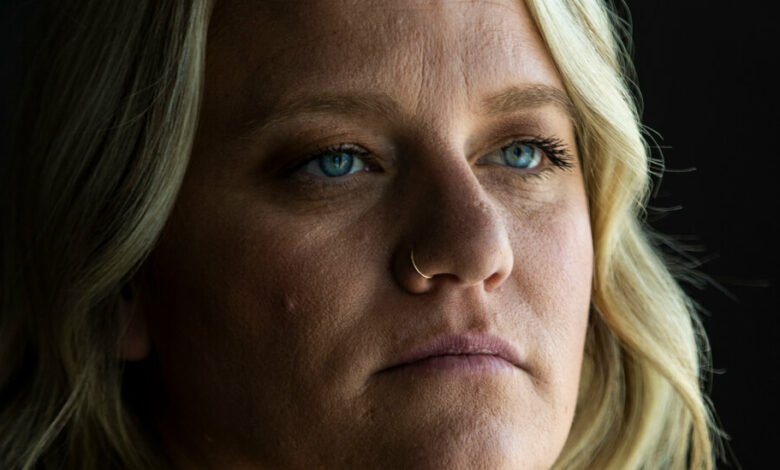She needed an emergency abortion. Doctors in Idaho put her on a plane.

Nicole Miller had gone to the emergency room in Boise, Idaho, after waking up in her 20th week of pregnancy with heavy bleeding. By noon, she was still leaking amniotic fluid and bleeding. Now she was panicking and struggling to understand why the doctor was telling her she had to travel out of state for treatment.
“If I need saving, aren’t you going to help me?” she remembers. She vividly remembers his response: “He told me he didn’t want to jeopardize his 20-year career.”
Instead, hospital officials at St. Luke’s Boise Medical Center put Mrs. Miller on a small plane to Utah that night, where she said she held her husband’s hand. She was afraid of flying, but even more afraid of never seeing her young daughters again. “I just have to stay alive so I can be around for my other two children,” nurses told her when she arrived at the hospital in Salt Lake City, 14 hours after she had been to the emergency room at home.
It was only when she woke up the next morning that she understood, because a nurse told her, that she had been flown over so that she could have an abortion.
“I couldn’t believe it: I’m standing in front of doctors who know exactly what to do and how to help, but they refuse to do it,” Ms. Miller said in an interview, her first since going through the ordeal. last fall.
The U.S. Supreme Court on Thursday declined to rule on whether states that ban abortions, such as Idaho, must comply with a federal law that requires emergency room doctors to perform abortions that are necessary to protect a pregnant woman’s health.
The justices sent the issue back to the lower courts for a decision, affirming a lower court ruling that the federal law, the Emergency Medical Treatment and Labor Act, did apply.
Abortion opponents accuse the Biden administration of trying to use federal law to turn emergency rooms into “abortion havens.” Exceptions to the abortion ban, they say, already give doctors the same latitude to perform abortions in genuine medical emergencies.
The Biden administration’s attempt to implement the law “is a PR stunt to spread the lie that pro-life laws prevent women from receiving emergency care,” said Katie Daniel, the director of state policy for Susan B. Anthony Pro-Life America, following the court’s ruling on Thursday.
Doctors in Idaho and other states where the ban is nearly complete say that even with newfound protections under federal law, they still have little clarity about what medical emergencies are covered. And little assurance that they won’t face charges, jail time, hefty fines and loss of their medical licenses if they provide care that a prosecutor says was unnecessary.
“The transfers and the difficulty in finding gynecologists willing to provide the care will continue,” said Dr. Alison Haddock, president-elect of the American College of Emergency Physicians, who is leaving her job in Houston this week for a position in the Pacific Northwest, partly because of the difficulty of working under Texas’ abortion ban.
Ms. Miller’s case illustrates the battle for doctors. When she arrived at the emergency room at St. Luke’s in Boise just before 6 a.m. on September 11, federal law was in effect because of the lower court ruling.
According to her story, which was verified by The New York Times, she had a placental abruption and her waters broke prematurely, but doctors at St. Luke’s said they could not legally give her the care she needed. By the time they put her on a plane to Utah, they estimated she had lost a pint of blood.
Doctors at St. Luke’s, Idaho’s largest hospital system and largest employer, say there was even more uncertainty after the Supreme Court temporarily suspended the law in January. In the four months since, the hospital has airlifted six pregnant women to other states for care; the year before there was only one, probably Mrs. Miller. (The hospital declined to comment specifically on her case, citing privacy laws.)
Idaho Attorney General Raul Labrador, a Republican, has questioned those numbers, noting that the doctors were not under oath when they provided them. “I would hate to see St. Luke’s or any other hospital try to do something like that to make a political statement,” he said after the Supreme Court heard oral arguments in the case in April.
Ms. Miller, now 39, will tell her story under oath this fall, as a factual witness in a lawsuit brought against the state by the Center for Reproductive Rights. “I want people to know that this can happen to anyone, it can happen to your sister, your wife or your daughter,” she said. “I never expected this to happen to me.”
She and her husband, Michael, had debated whether to have a third child. It took longer than expected, but they were thrilled when she became pregnant via intrauterine insemination, and even happier when they found out they were having a boy.
They had already named him Maddox David when Mrs. Miller began to notice signs of her pregnancy around 17 weeks into the pregnancy. Her obstetrician saw from ultrasound scans that she was leaking amniotic fluid and referred her to a fetal medicine specialist.
Before Mrs. Miller could see the specialist, she woke up with bleeding. She called her mother to watch her daughters, then she and Mr. Miller went to the emergency room.
Ms. Miller said doctors told her the fetus still had a heartbeat and that she would have to leave Idaho for care. They first transferred her to a delivery triage unit, where doctors said the fetus was in danger. When the doctor told Ms. Miller he couldn’t risk his career to get her the care she needed, the medical student standing next to him cried. “I assume that was because she was in shock and what happened,” Ms. Miller said.
Yet no one was talking about abortion or abortion, she said. “It was, ‘We need to get you to a place where you have all your options.’”
Ms. Miller knew little at the time about Idaho’s law that prohibits abortion except to prevent the death of a pregnant woman, in some nonviable pregnancies, or in some cases of rape and incest.
Looking back, she sees the law as having put doctors in a difficult position. “They’re also at a lot of risk,” she said. “But that doesn’t take away from how traumatic it was for me to be in a hospital where you’re supposed to be getting care — and be told, ‘We can’t do anything for you.'”
She was taken to the plane by ambulance with her husband, a nurse and a paramedic. The nurse “just kept looking at me and shaking his head that I was going to be OK and that he had me, because he could physically see how scared I was,” Ms Miller said. “He was really the first person that day that showed any kind of compassion.”
Mrs. Miller’s mother and daughters rushed to meet them in Salt Lake City, a five-hour drive.
In Salt Lake City the procedure, a dilation and evacuation, went smoothly. Mrs. Miller was fired two days later; she and her husband returned a few days later to retrieve the fetal remains.
Doctors and hospitals in Idaho say they too have been on what the state’s medical association’s executive director, Susie Pouliot Keller, called a “roller coaster” since Roe v. Wade was overturned two years ago, giving Idaho a ban on abortion.
More than half of the state’s gynecologists have left the state, many citing the uncertainty and difficulty in providing necessary care under the ban. Three hospitals have closed their obstetric departments because they cannot find enough doctors willing to work there.
Thursday’s Supreme Court decision offered some relief, said Dr. Duncan Harmon, an obstetrician-gynecologist at St. Luke’s. Still, he said, there are cases where the law doesn’t make it clear whether abortion is allowed.
He must consider the threat of criminal sanctions and prison sentences, for himself and his family. “I want to work as best I can to take care of my patients, but my family is my top priority,” he said. “I would love to be a martyr for my work, but not all of us can.”
Mrs. Miller has been to a maternal fetal medicine specialist to discuss whether she can try again for a third child. The doctor told her that the risk of placental abruption, while low, was slightly higher for women who had experienced it before.
“It’s something I struggle with every day,” Ms. Miller said. “Because as much as I want another baby, I also have two little girls who need me.”
She added: “If I were to find myself in that situation again, it could go either way. The fact that I don’t have anyone here that I can fully trust to help me, it seems like an impossible decision.”




